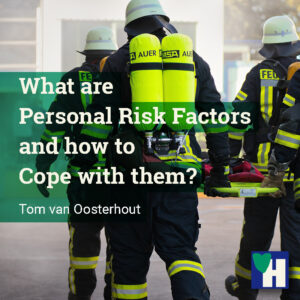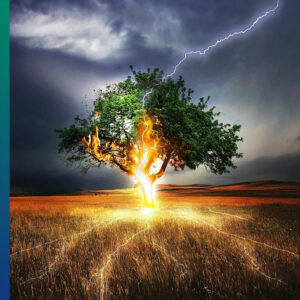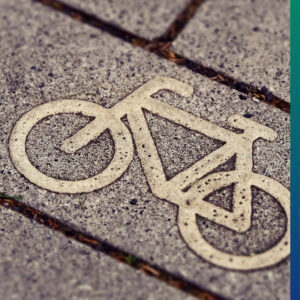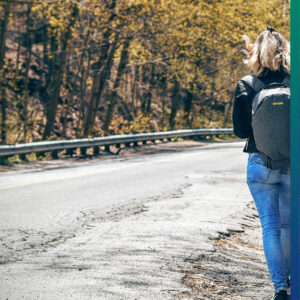
What are personal risk factors and how do I cope with them? This is a recurring question in most comments people write in response to our articles. When someone asks what personal risks are, the word virus does wonders these days.
However, in our articles, we often write about totally different risks. Most of us are very familiar with these risks: the pollution of the air, the water, the soil, our food, and the destruction of biodiversity and ecosystems. Unfortunately, not everybody understands the link between these so-called impersonal risks, and the risks we think are more personal, such as a virus.
When we answer the questions people ask us, we try to share as many practical ideas as possible, without getting too pretentious. Being this practical is always appreciated.
However, sometimes the big picture disappears into the background. In this article I dig a little bit deeper, explaining to what extent personal and impersonal risk factors are linked and how we can cope with them.
Some of the links are affiliate links. As an affiliate associate, we earn a commission when you purchase any of the products offered through the shared links at no extra cost for you. This helps us maintain this website.
Table of contents
What are personal risk factors?

We invest a substantial amount of time and effort in controlling the risks we perceive. This is the first step in understanding the link between personal and impersonal risk factors. From the following 4 examples, this link is immediately obvious:
- We wash ourselves to stay clean. A lot of the dirt on our body is very impersonal;
- What we wear protects us against such impersonal practicalities as the sun, the rain, and the cold;
- When we drive a car, we better stick to the rules the impersonal government issued. Not just for the safety of ourselves, but perhaps more so for the safety of others;
- With all those fast driving very impersonal cars we watch where we walk.
The controlling of all these risks weighs heavy on us. Especially because the risks are numerous.
When we move on in life, it becomes increasingly more difficult to control all these risks, let alone when we’re faced with new and unexpected risks. That is partly because we have already invested heavily in coping with the risks we’re familiar with. The investment makes us very dependent.
Path dependency

This so-called path dependency does of course prevent us from personal and impersonal risk factors. This brings me to the second step in understanding the link between personal and impersonal risk factors: path dependency makes us less resilient to new and unexpected risks. The destruction of biodiversity and ecosystems are excellent examples of new and unexpected risks.
How do we perceive these new and unexpected risks? Our experience is that most of us avoid confrontation. Usually, because we do not understand this type of risk. Which is normal, otherwise they wouldn’t be called new and unexpected. Moreover, we perceive most new and unexpected risks as impersonal.
The handling of this type of risk, we gladly leave to others and the government. We tend to avoid responsibility, put our heads in the sand like ostriches, and stop all critical self-reflection: “New and unexpected risks? Please, not in my backyard!”
However, how do we keep the risks of the pollution of the air, the water, and our food out of our backyard, let alone out of our house or out of our body? Who is defending our right to a risk-free life?
What are personal risk factors and how to cope with them?

To act like ostriches doesn’t feel like a sound strategy when challenged with our risks. Nevertheless, the best way to charge these risks is head-on, yet at the same time, with as much care as possible. I perceive this as the third step in understanding the link between personal and impersonal risk factors.
The following 3 examples illustrate how our risks can be charged head-on with care: trust, a risk-free life, and traffic participants.
Trust
We protect our personal physical integrity with such things as clothes, a house, hygienic provisions, and safe foods. The list of protective impersonal provisions is endless: from sewage structures to academic hospitals and from highly complicated legal systems to expiration dates on food packages.
Despite all the personal protective provisions, we still feel highly vulnerable. This might be because we have no control over the many protective impersonal provisions that safeguard us? We have few control instruments left but to trust those who are responsible for these impersonal provisions.
The challenge with trust is that it’s a two-way street. Of course, those who are responsible have a duty to install trust. The interesting question is, however, what do we ourselves, personally invest in the trust of those that are responsible.
Risk-free life
As it appears, it’s indeed our lack of trust in those responsible that makes us feel vulnerable. This lack of trust usually emerges when we’re faced with the tireless and never-ending discussions about those very few things that go wrong. We don’t want anything to go wrong! We want a risk-free life!
Although the aim to prevent anything to go wrong is imaginable, it’s an aim we cannot afford. That’s why it’s inevitable that we reflect on our own behavior, and wonder what we can do ourselves to improve the way we handle risks.
Invest time and effort in understanding these risks. Try to assess what are the personal risk factors. Moreover, try to imagine what a personally risk-free life looks like. Do you see it? You cannot afford it.
Traffic-participants
Let’s take an old and well-known risk of everyday life as an example: the way we drive around on the roads in our cars. For starters, that is just what many people do: they drive around in their car. They’re alone on the road. They are the opposite of what I call ‘traffic participants’.

When Hannie and I go out for a walk, we often have to share the road with cars. Where we walk there are speed limits and speed bumps. Most drivers ignore the speed limits and only slow down when they reach a speed bump, not when they reach us. This is a fine example of the link between personal and impersonal risk factors, don’t you think?
There are three reasons why relatively few people get hurt in accidents. People don’t want their cars to be damaged. The passive safety of cars (this is the safety of the passengers inside the car) is these days at an exceptionally high level. And third, there are just enough people, although this is a very small number, that do feel responsible.
They anticipate what others do, abide as much as possible by the traffic rules, plan their trip, and don’t use their car as a disco or race monster, which can be heard all the way to the other side of the city. These ‘traffic participants’ use their car where it’s made for, to drive from A to B.
Rules of thumb
Inform yourself, abide by existing rules, anticipate, and invest in the trust of others, these are some rules of thumb that anyone can practice if encountered with personal and impersonal risk factors.
To challenge you to pick up these rules of thumb, I have designed a very simple exercise.
Try to invent 1 rule that you think other car drivers would appreciate you would abide by, apart from the obvious traffic rules.
Please let me know what you came up with in the comment box below.


Well, I guess that I was one of these people who mingled impersonal and personal risks in their daily lives. Until now. So thanks for your article! I don’t think personally that life is totally risk-free. However, we must do our best to prevent them, especially if we are in perilous situations, like a traffic jam. As you also said in your article, our physical integrity is very important to cope with our personal risk.
Your welcome. We always hope our articles are appreciated. So it’s even more fun when someone shares this with us.
Life is never risk-free. You are born and you die. In between all kinds of things happen. You will never be able to control those things, let alone prevent them.
We depend on the trust and the good intentions of others. We depend on others for almost anything. This is why we’re so hooked on the idea that we’re all individuals.
Did you ever saw Monty Python’s movie The Life of Brian? There’s an amazing scene in this movie. In this, Brian, who everybody believes is the savior, stands in the window of his mothers’ house and oversees the crowd. The crowd shouts his name. Brian feels very uncomfortable and addresses the crowd, saying: “You should not follow me. You’re all individuals.” Instantly all the members of the crowd shout: “We’re all individuals.”
That sums up our life pretty accurately: we all think we’re individuals until proven otherwise. We are stuck with this wisdom and have to live with it.
Thank you for your comment.
Regards,
Tom
Nearly all risk factors do not only affect us but everyone else in our immediate surroundings. Although I love driving I don’t like that I have always have to keep an eye out for the ones who just race over the road and seem to think that the rearview mirrors and indicator lights are just some accessories they don’t have any use for.
Well, I live in Mexico and driving is different here. I got used to it, but it is a fact that one has to be on the defensive here when on the road, always watching out, ALL THE TIME … There have been occasional moments when I was distracted, I think it happens to everyone and in my case it usually happens when I’m upset about something. I always tell myself not to drive when I’m upset. So, that would be my personal traffic rule to benefit others, “don’t drive when you’re upset.” Otherwise, it’s pretty much avoiding the gocarts – I mean cars 😉 on the road, that’s what it sometimes feels like here.
Hi Christine,
Our daughter-in-law always says that those cars, whose drivers don’t use indicator lights, are the cheap cars, they don’t come with indicator lights. I’m always surprised by the relatively low number of fatalities, given the awful behavior of many drivers. That’s part of the governments’ risk control. Road bumps, traffic lights, separate lanes, etc.
You’re right, that is very sound advice: Don’t drive when you’re upset. For me, the problem is, however, that I can be very upset by the way others behave in traffic. What helps, is that I say to myself that I also make mistakes now and then. Which is true by the way. Afterwards, when I’ve made a mistake, I’m always very ashamed of myself.
What I also try, is to invest a lot of effort in showing other traffic participants, specifically the weakest ones, such as pedestrians and cyclists, what my intentions are.
Based on your explanation of the traffic culture in Mexico, perhaps it’s best when I don’t go there. Although I must admit that in Spain a lot improved since the first time I drove a car here. That must have been more than 40 years ago. How time flies.
Thank you again for your comment.
Regards,
Tom
An excellent article, Tom! Yes, life is certainly not risk-free. A risk-free life doesn’t exist!
When I drive the roads, I am angry about the drivers who pass my car in dangerous moments, nearly causing an accident. I think it is because of the drug use by the people. You are also from the Netherlands and know that people can buy all kinds of drugs in the coffee shop, but there is, of course, also an illegal trade.
These days, many people drive under the influence of medications, slowing them down and preventing the clarity of their perception. I believe this is a real problem in participation in the traffic.
The government’s trust factor and decisions indeed decreased due to the affairs and wrong choices, especially when they do not even admit and apologize but say that they have no remembrance of the situation. It is ridiculous, and combined with the wrong action plan towards the virus, suppressing every warning voice of real experts and listening to people entangled with Big Pharma and a huge income. This all makes me angry, and I ask myself why people are not thinking and requesting answers to the topic but still trust governments. Thank you very much, Tom! 🙂
Hi Sylvia,
Thank you for your comment and compliments.
People trust governments because governments are so powerful that they don’t know who else to turn to. Most people most certainly don’t even trust their neighbors.
There’s an interesting example of the way in which this works out. A local government gave a neighborhood money to spend on the improvement of local shops. The government promised not to interfere in their choice and the way they executed this choice. The neighbors could not agree on a way to spend the money. Asked why not, they said they didn’t trust each other enough to spend the money in an honest way. Which they believed only the government could because it was neutral.
A friend of ours, who lives in Belgium, is very active in citizens’ collectives which more and more take over tasks of commercial companies and governments. He participates in, amongst many others, a citizen’s bank (NewB) and a citizens’ collective which produces green energy (Druifkracht). These are national citizens’ collectives. There are of course many local and regional citizen collectives. And of course international ones, such as Amnesty International and Greenpeace. When we still lived in The Netherlands we were members of ODIN, a chain of organic shops.
These collectives combine citizen powers to counter too powerful commercial and governmental interests. We should all, more and more participate in such initiatives. Provided of course, they genuinely improve the way we live.
Stay safe, stay healthy.
Regards,
Tom
The traffic in my city is insane, not to mention the fact that drivers have almost zero tolerance if I’m on my e-scooter, it’s like I don’t even exist, the same goes if I’m riding my bike. We have no subway, just a tram but it gets way too crowded during warmer weather so that’s a no for me.
Hi Emma,
Thank you for your comment.
Good for you that you drive an e-scooter and a bike. They are both a great asset to your mobility. A bike is also good for your health and condition.
Public transport is always a challenge. I love public transport. But your fellow travelers can really get on your nerves. I used to commute for about 10 years. Let me share some interesting anecdotes with you about my experiences.
When everybody tried to read a newspaper or sleep off the early morning, two employees of the Department of Education loud and clear started to discuss departmental policy and social issues. For various reasons, this is not done. They did not only distract everybody but also embarrassed us because we had to share their gossip. But this was before they invented so-called silent train units.
I once sat in a silent train unit when 4 elderly women entered and sat down. They were clearly returning home from a day out in the big city. “O, how nice,” one lady said with a high-pitched voice, “this is a silent unit.” This was clearly a signal for all four of them to start to discuss out loud all their most intimate family affairs.
Keep up the good work.
Regards,
Tom